Beyond NPS
Editor's note: Erin Leedy is SVP technology at Livonia, Mich.-based research company Market Strategies International. Special thanks to Praveen Chalise and Randy Hanson for their contributions to this article.
 Our firm is often asked to recommend research approaches that guide decisions about marketing, as well as product and brand management. A topic that’s been of great interest among our clients lately is brand health. Net Promoter Score (NPS) has been the go-to measure for some time but there are numerous other research approaches that may be used to gauge and track brand health over time – some of which may be better-suited to brands in sectors that may not be well served by an approach built around promotion. We were curious to compare NPS to other brand health measures in a controlled way, so we used our quarterly consumer omnibus study as a research sandbox to allow for some investigation.
Our firm is often asked to recommend research approaches that guide decisions about marketing, as well as product and brand management. A topic that’s been of great interest among our clients lately is brand health. Net Promoter Score (NPS) has been the go-to measure for some time but there are numerous other research approaches that may be used to gauge and track brand health over time – some of which may be better-suited to brands in sectors that may not be well served by an approach built around promotion. We were curious to compare NPS to other brand health measures in a controlled way, so we used our quarterly consumer omnibus study as a research sandbox to allow for some investigation.
Specifically, we fielded various questions and used the results to test the efficacy of brand health approaches that would serve clients across industry sectors well. We surveyed more than 1,100 U.S. consumers regarding brands in the social media space. We then used these data to run multiple brand health analyses, ultimately comparing NPS and several brand health measures and indices at how well they predict our dependent variables: frequent use of the brand and intention to increase use of the brand in the near future.
If your company uses NPS (and particularly if you’re using nothing but NPS), we encourage you to keep reading. At the end of this article, you may find yourself:
- considering the pros and cons of NPS and how to optimize it using other approaches and measures;
- engaging with clients, internal customers and stakeholders to determine the best approach for measuring brand health given the marketplace, brand position and goals;
- evaluating brand health approaches that employ multiple measures (e.g., NPS, other primary research results, customer transactional/behavioral data, data from social media, etc.) for a more holistic health assessment.
Before we dive into our study results, however, here’s a brief look at NPS as a measure. NPS is a management tool used to gauge a brand’s customer loyalty or brand health. It grew out of dissatisfaction with customer satisfaction research and a desire to focus on a metric that better measures loyalty.
The metric was developed by Fred Reichheld, Bain & Company, and Satmetrix; Reichheld introduced it in a 2003 Harvard Business Review article. The Net Promoter Score (subtracting brand Detractors from Promoters) was presented as “the one number you need to grow.” NPS scores range from -100 (all Detractors) to +100 (all Promoters). A positive net score is deemed good; a score of 50+ excellent.
Acceptance of NPS was strong and swift, as it moved away from long questionnaires and complex satisfaction models. However, it has also been criticized regarding its efficacy. Historically, customer-related initiatives focused on: continuous improvement – maximizing high scores; or minimizing defects – eliminating low scores/performance.
On the surface, NPS seems to be an effective combination of the two but in practice, NPS blurs the issues:
- As is the case with any net score, vastly different scenarios can result in the same Net Promoter Score and require different actions from the brand.
- Because NPS itself can hide so much, questions usually follow. “What are the Promoter and Detractor percentages?” “NPS went up last wave, so what changed? Do we have more Promoters or fewer Detractors?”
NPS can be a valuable tool when there’s a desire for simplicity – a single question to be posed and tracked, which can be attractive to senior management – as well as a desire to use a metric that’s known and well-established. But it is not without its drawbacks.
Before diving into alternate approaches for measuring and tracking brand health, let’s consider the benefits and drawbacks of NPS (see chart) as a single measure of brand health.
Given the limitations of NPS as a sole measure for brand health, approaching brand health more comprehensively – whether via multiple measures or a calculated index score, incorporating NPS or setting it aside – may prove more useful. It’s this broader approach that we recently decided to play with in our research sandbox.
To test some brand health approaches, we recruited 1,128 qualified respondents 18 years or older and living in the U.S. via panel to take an online survey about 12 popular social media brands: Facebook, Flickr, Google, Instagram, LinkedIn, Pinterest, Reddit, Snapchat, Tumblr, Twitter, Vine and YouTube.
We asked respondents about: top-of-mind, unaided and aided awareness; familiarity with each brand; usage (mobile vs. browser; frequency of use; change in future usage frequency); 12 social media attributes (brand fit); positive or negative view of the brand; overall satisfaction; and likelihood to recommend.
Given what we know about the social media space, we identified two behaviors that seemed to fit with a healthy social brand: consumer frequency of use and intended frequency of use going forward. Our brand health analyses would focus on what measures – whether brand awareness, promotion, satisfaction, strong performance on various brand attributes – would more strongly predict the desired behaviors of frequent use now and in the future.
Overall brand data
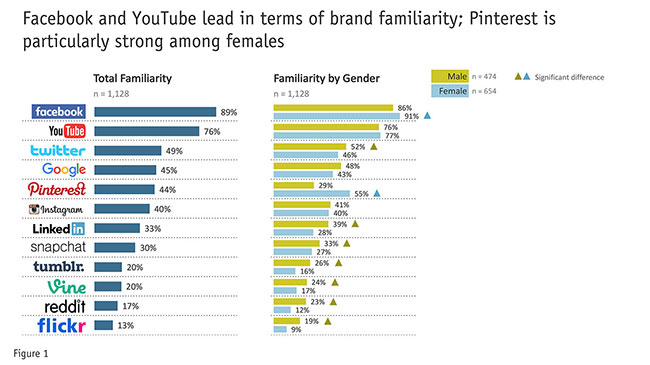 Before we dig into brand health, let’s start by looking at some overall market brand data. Here’s what we found regarding the brands’ relative footprints in the U.S. As shown in Figure 1, Facebook and YouTube lead in terms of brand familiarity and Pinterest is particularly strong among females.
Before we dig into brand health, let’s start by looking at some overall market brand data. Here’s what we found regarding the brands’ relative footprints in the U.S. As shown in Figure 1, Facebook and YouTube lead in terms of brand familiarity and Pinterest is particularly strong among females.
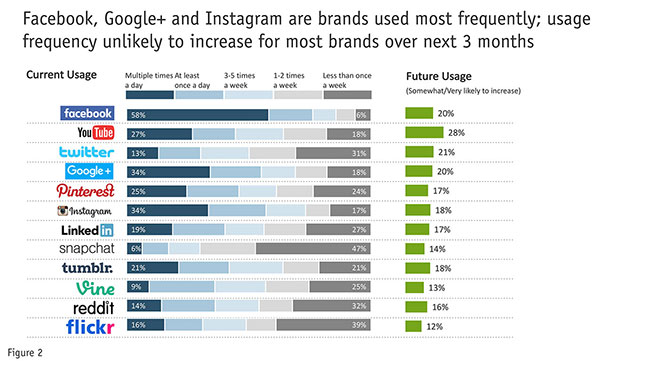 We also find that respondents use Facebook, Google+ and Instagram most frequently and that usage frequency looks relatively stable for most brands over the subsequent three months, with modest increases indicated (Figure 2).
We also find that respondents use Facebook, Google+ and Instagram most frequently and that usage frequency looks relatively stable for most brands over the subsequent three months, with modest increases indicated (Figure 2).
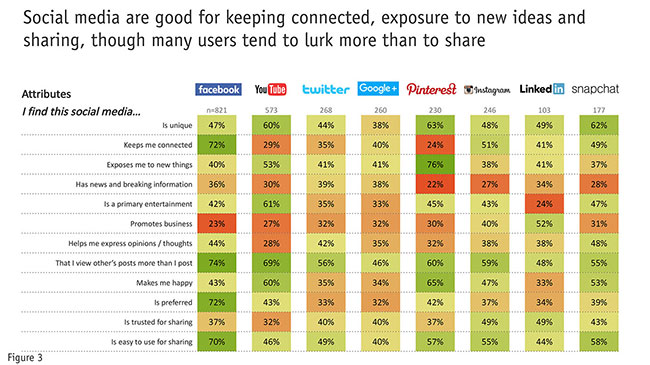 We see a good deal of brand differentiation on various brand personality attributes, which is helpful when hoping to use such attributes to develop a brand health score. Social media are deemed good for keeping connected, exposure to new ideas and sharing, though many users tend to lurk more than to share (Figure 3).
We see a good deal of brand differentiation on various brand personality attributes, which is helpful when hoping to use such attributes to develop a brand health score. Social media are deemed good for keeping connected, exposure to new ideas and sharing, though many users tend to lurk more than to share (Figure 3).
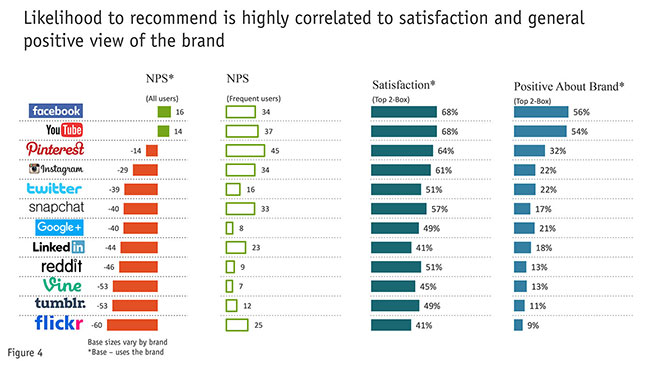 As you might expect, likelihood to promote a social media brand is highly correlated with brand satisfaction and a general positive view of the brand (Figure 4).
As you might expect, likelihood to promote a social media brand is highly correlated with brand satisfaction and a general positive view of the brand (Figure 4).
NPS alternatives
Using those findings as a baseline, we began our investigation into NPS alternatives. We wanted to find a question or set of questions that would do a good job at identifying a healthy social media brand, with healthy, in this case, defined as a brand that was being used frequently now and going forward. In our research, we used results from the consumer behavior questions – frequency of use of the brand and inclination to increase this use going forward – as a proxy for actual usage behavior. In the real world, if a social media company were developing a brand health program, they could incorporate actual usage data into their analyses over time.
Our analyses included a series of brand personality attributes, higher-level brand health measures and the two usage variables that we were aiming to predict.
Personality attributes: a series of rated statements such as…
- I find [brand] unique – there’s no other social media platform like it
- I use [brand] to get new ideas and be exposed to new things
- I get my news and breaking information from [brand]
- [Brand] is a primary source of entertainment for me
- [Brand] helps keep me connected to those I care about
Higher-level measures:
- What is your view of [brand]?
- Overall, how satisfied or unsatisfied are you with each of these social media brands?
- How likely are you to recommend this social media brand to others you know?
- Net Promoter Score
Dependent variables:
- How often do you use each of these social media platforms via the Web site or the mobile app?
- Over the next three months, do you expect your use of this social media platform to…?
We evaluated multiple solutions and identified several that did a good job of predicting one of the behaviors: high overall usage or high intended future usage.
We found that a brand health score comprised of results from three rating questions – consumers’ positive view of the company, whether the brand helps a consumer to “promote myself/my business,” whether the brand helps consumers “get breaking news” – was better than NPS at predicting high intended future usage.
We found that a brand health score comprised of results from three rating questions – consumers’ overall satisfaction with the brand, consumers’ positive view of the company, whether the brand “keeps me connected” – was better than NPS at predicting high current usage frequency.
Ultimately we selected the second solution as the best outcome for this test study, as it focuses on current behavior instead of anticipated future behavior (which might end up being different from what’s anticipated).
Here we can take a look at our brand health index score and how the various companies stack up (Figure 5).
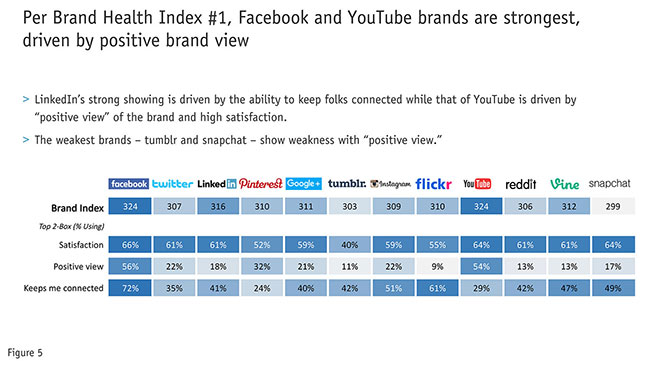
Facebook and YouTube brands are the healthiest, with strong performance driven by both overall satisfaction and strong positive brand view among consumers. Facebook is particularly strong when it comes to “keeps me connected” as well. A bit behind the leaders, LinkedIn’s strong showing is driven by its ability to keep people connected. The least-healthy brands – Tumblr and Snapchat – show weakness when it comes to having a strong positive brand view.
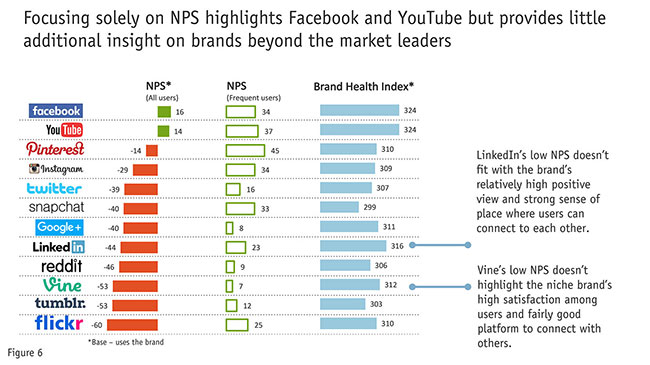
We can compare brand results for NPS and our health index and draw some useful insights (Figure 6). If we were to focus solely on NPS, we’d still see strong scores for Facebook and YouTube but we’d miss additional insight on brands beyond the market leaders. LinkedIn’s middling NPS doesn’t fit with the brand’s relatively high positive view and strong sense of place where users can connect to each other. Vine’s low NPS doesn’t highlight the niche brand’s high satisfaction among users and its strength as a platform on which people can connect with others.
A useful measure
We see NPS as a useful measure when asked and analyzed along with other measures of brand health that look beyond customer brand promotion. Multiple measures may be used, whether independently or indexed, to get a broader understanding of a brand’s health as compared to the competition.
When making decisions about which brand attributes to measure and track, a company should take a good look at its brand given the broader market context, as well as what characterizes a healthy brand within that space. When designing a brand health study, the research team should include questions that measure distinct brand strengths, which may include other engagement measures beyond promotion.
Clarity: Do I know this brand and what it stands for? Does the brand stand for something unique in the market?
Relevance: Does the brand fit my needs? Do I choose to use the brand?
Congruency: Does the brand consistently deliver on its promise?
Engagement: Am I engaged – do I advocate for the brand? Do I engage with this brand over others?
Keep in mind that beyond survey results, additional measures may be incorporated into brand health scores:
Data from social media. Social media data for brands – comparative volume, sentiment and engagement measures – may be used as a component of brand health.
Customer transactional/behavioral data. Beyond incorporating into the health score itself, customer data may be appended to help characterize research results (e.g., profiling customers who give high brand health score vs. those who give low score for better diagnostics). Note that this is a customer-focused approach, as it’s often difficult to obtain behavioral data for non-customers.
Pay off soundly
As shown in this study, NPS/promotion may be incorporated directly into a brand health score, considered as a separate brand health measure or excluded entirely. Ultimately, the decision about what measure(s) to use for brand health is an important one that may take some time to resolve but the work put in upfront in determining the best approach should pay off soundly as the well-considered brand health program takes off.
